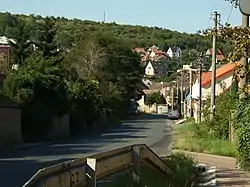Libušín | |
|---|---|
 View of Libušín | |
 Flag  Coat of arms | |
 Libušín Location in the Czech Republic | |
| Coordinates: 50°10′6″N 14°3′17″E / 50.16833°N 14.05472°E | |
| Country | |
| Region | Central Bohemian |
| District | Kladno |
| First mentioned | 1052 |
| Government | |
| • Mayor | Vladimír Eichler |
| Area | |
| • Total | 9.48 km2 (3.66 sq mi) |
| Elevation | 317 m (1,040 ft) |
| Population (2023-01-01)[1] | |
| • Total | 3,403 |
| • Density | 360/km2 (930/sq mi) |
| Time zone | UTC+1 (CET) |
| • Summer (DST) | UTC+2 (CEST) |
| Postal code | 273 06 |
| Website | www |
Libušín is a town in Kladno District in the Central Bohemian Region of the Czech Republic. It has about 3,400 inhabitants.
Etymology
The oldest entry of the name of the village was Ľubošín. The name was derived from the personal name Ľuboša, meaning "Ľuboša's (property)".[2]
Geography
Libušín is located about 4 kilometres (2 mi) northwest of Kladno and 20 km (12 mi) northwest of Prague. Almost the entire municipal territory lies in the Prague Plateau, only a small part in the west extends into the Džbán range. The highest point is at 424 m (1,391 ft) above sea level.
History
According to archaeological finds, there was a Slavic settlement already in the 6th–7th century. At the end of the 9th century, a gord was built here. The first written mention of Libušín is from 1052. In 1277, it was donated to the Ostrov Monastery in Davle by King Ottokar II. In 1514, the Martinic family bought Libušín and owned it until the 20th century.[3]
In 1775, black coal was found near Libušín. The coal mining in the municipal territory started in 1885, when the first of three mines in Libušín was opened. The coal mining increased the town's population and accelerated its development.[3] The coal was mined here until 2002.[4]
In 1919, Libušín became a town, but for the period 1961–2006 it lost its town status.[3]
Demographics
|
|
| ||||||||||||||||||||||||||||||||||||||||||||||||||||||
| Source: Censuses[5][6] | ||||||||||||||||||||||||||||||||||||||||||||||||||||||||
Culture
Libušín is known for its annual huge medieval festival with the biggest medieval historical reenactment in the country and one of the biggest in Europe. It was established in 1991. The battle is fictional and not based on a historical event.[7]
Sights

The Church of Saint George was probably founded in the 10th century in the gord's area. In 1650 the church took its current Baroque shape. Its location away from the town centre was the reason why another church was built in 1908 – the neo-Gothic Church of Saint Procopius.[3]
The area of Church of Saint George and remains of the gord include a wooden bell tower built in 1500.[3]
The mining tower together with the mining building were inscribed on the list of technical cultural monuments.[4]
Notable people
- Jiří Pauer (1919–2007), composer
- Josef Frolík (1928–1989), CIA spy
- Zdeněk Herman (1934–2021), physical chemist
References
- ↑ "Population of Municipalities – 1 January 2023". Czech Statistical Office. 2023-05-23.
- ↑ Profous, Antonín (1949). Místní jména v Čechách II: CH–L (in Czech). p. 604.
- 1 2 3 4 5 "Historie" (in Czech). Město Libušín. Retrieved 2021-06-24.
- 1 2 "Důl Schoeller" (in Czech). Kladno minulé. Retrieved 2021-06-24.
- ↑ "Historický lexikon obcí České republiky 1869–2011 – Okres Kladno" (in Czech). Czech Statistical Office. 2015-12-21. pp. 5–6.
- ↑ "Population Census 2021: Population by sex". Public Database. Czech Statistical Office. 2021-03-27.
- ↑ "Úvod" (in Czech). Bitva Libušín. Retrieved 2021-06-24.